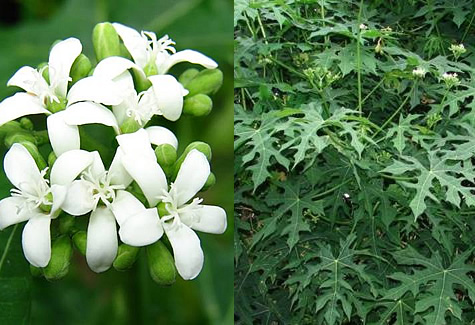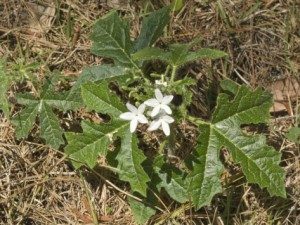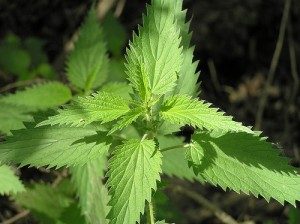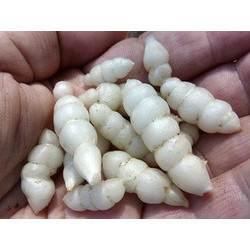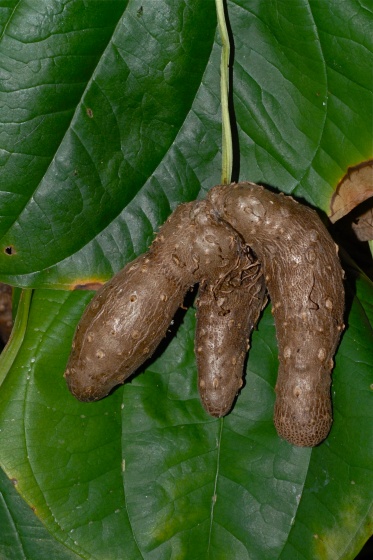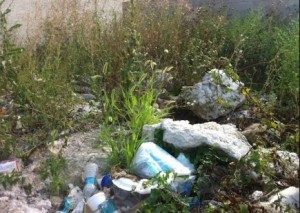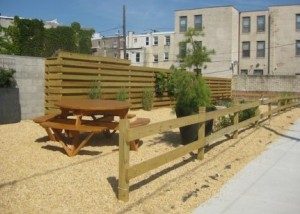Had a great class in Winter Park this past weekend and ended up going home with a gift, a chaya tree from Tia Meer whose growing a whole bunch of them. Thanks Tia.
Chaya has edible foliage but as a tropical doesn’t like cool temperatures. For a while I knew of only one growing in the greater Orlando area. Tia is changing that with an eye on commercial production. Chaya is certainly a major crop farther south. Further north one might have to pot them and take them inside during the winter. At Mead Garden where the class was held there are two of them. I have added it to my potted collection which includes: Lemon Grass, Nopales, an apple that sprouted under my Apple Ana, and an Ivy Gourd.
The water was high at Mead but we managed to rummage around and find several dozen edibles. Florida Betony is up but not putting on roots yet. False Hawk’s Beards are all small, a reminder that our annual winter weeds will be on their way soon. and Creeping Cucumbers are seeding heavily. One nice surprise is that is coming back from the summer heat. It can nearly disappear in late summer. But along the stream that wends through Mead smartweed was healthy and in blossom. We had to try it to see if it lived up to its peppery reputation. It did. Perhaps because of spraying — spraying in a park? — we saw only one spindly example of Barnyard Grass, which is in seed. It was a fun class which reminds me that I will be in West Palm Beach for classes both Saturday and Sunday this week. Details are here.
Mentioning Chaya brings up nettles. Locally we have a spurge nettle (Cnidolscolus) that is around almost all year. It’s related to the Chaya above. However, stinging nettles (Urtica) show up around Thanksgiving and are gone by the time you pay your taxes in April. They are two very different families, two very different plants. Other than both being green they look nothing like each other but people get them confused all the time. The problem is common names. They’re both called nettles and they both sting. With one (Cnidolscolus)you definitley eat the root because the leaves have some cyanide in them. With the other (Urtica) you definitely eat the leaves. And again this past week I received yet another email from the spurge nettle page that I didn’t mention one can eat the leaves. Let me repeat the edible parts: Stinging nettles leaves, spruge nettle roots.
I am not a stickler for people learning the botanical names of plants. What is more important is being able to identify the plant. But too many people put too much faith in the common name. As I’ve written before there’s about a dozen and a half “pigweeds” in the United States, some of them edible, some of them deadly. Botanical names exist for a reason which is to make sure we are talking about the same plant. What’s even more difficult is when there is a personal name for a common plant. That’s when only your family calls something like the toxic flower Four O’Clocks “Indian Potatoes” when no one else on earth does… and you think they are edible because your family calls them “Potatoes.”
Fortunately with the nettles the mix-up is not fatal. In fact, spurge nettle leaves — the ones with a little cyanide — might be edible. They jury is out on that one. You can read about that issue here.
Winter Weeds: Now that cool weather is here with temperatures in the 80s it is time to start thinking about Winter Weeds. Many plants that are summer foraging half a country away (same in Australia and South Africa) are winter weeds here. As mentioned above I am just starting to see our False Hawk’s Beard coming up. This time of year look for them in shady area. In another month we should be seeing our winter crop of sow thistles and fireweed. As you may know Florida Betony shuts down for the summer time but with the temperature drop, particularly the 70s at night, it’s beginning to perk up. No edible roots yet, perhaps by Thanksgiving Day. Also starting around Thanksgiving start looking for the above stinging nettles (Urtica) in shady areas and in sunny spots by Christmas. And Christmas time is a good time to start looking for chickweed in various lawns. It doesn’t last long, perhaps to Valentines Day maybe even St. Patricks day in a cool year. Also in early December start looking for Cucumber Weed (Pellitory) in the shade. It’s prolific in the first three months of the new year but can be found only in deep shade by April Fools Day. The cooler months also encourage the mustard family from the Bittercress to Wild Radishes to more prolific Poor Man’s Peppergrass and little mustards. We are fortunate in being able to forage all year locally.
Newly added article: Buttercups.
If you’ve been confused about identifying our prime wild yam this is one time of year when identification is easy. We have eight native yams, and three imports two of which are prolific. The three non-native produce “air potatoes” which are essentially a second form of reproduction. In six weeks or so the vines will begin to die off for winter and drop the “potatoes’ which will root and produce a new vine in the spring (as will the roots as well.) We don’t eat the air potatoes. Use them to identify the vine which has an underground root that is edible. The prime yam to look for is the Winged Yam, Disocorea alta. You are looking for an air potato that is dark brown, candle-shaped, upsidedown Y-shaped, L-shaped or lumpy like a small pile of manure. They are NOT round, they are NOT semi-round, they are NOT round, spotted, and brown, they are NOT tan. Let me repeat that last one: They are NOT tan. When you find a dark brown candle-shaped, upside down Y-shaped, L-shaped or lumpy air potato you should also find a square stem, opposite leaves, and twisting as it grows from our lower left to our upper right. Follow that vine down to the ground and within inches of the surface you should find a a root that will be, in the wild, five to 10 pounds. Cook it like a potato.
Which is more dangerous? Foraging or swimming? On average one person a year is killed by a shark, six world wide. About five people a year die from rattlesnake bites in the US which is very few when you consider how many people are traipsing around the great outdoors. Around six people a year in the US are killed by spider bites (I was bitten once in my right arch by a brown recluse right at the beginning of a vacation. It was a pain in the foot though my opinion was about a yard higher.) Horses account for 20 deaths annually in the United States, cows 22. Dogs do in some 35 people a year in the US. Jelly fish kill around 40 worldwide every year, ants 50, bees 53. Deer take out around 130 people a year in the US, usually when hit by a car. Hippos are ill-tempered and kill some 2,900 people in Africa annually. Topping the list is mosquitoes which cause around 655,000 deaths a year from the diseases they spread. How many adults die from foraging wild food? About one a decade, and almost always after eating either the water hemlock or its relative the “poison” hemlock. To learn how to identify those dangerous plants click here
Either the same folks who cited me twice for my food-producing lawn have moved to Philadelphia or civil service bureaucrats are similar beasts no matter where you live.
A Philly businessman took his own money and changed a trash-filled city-owned lot overgrown with (non-edible) weeds into an attractive mini-park. Long-irritated neighbors sang his praises but the city calls him a trespasser and is threatening to take him to court
Ori Feibush, left, a real estate developer, tried to buy the neglected 1,600-square-foot lot for years, but the city said no. In August he was getting ready open a coffee shop next to the rundown lot when he decided to do something about it.
“I didn’t wake up one morning and spend tens of thousands of dollars to remove blight that was a danger to residents and customers,” he said.
Before starting the project Feibush went to the Philadelphia Redevelopment Authority telling them what he had in mind. He said that the agency told him that it would take care of cleaning the lot and that he did not have permission to enter it. But the city did nothing.
“They promised they would get around to it,” Feibush said. “I did not believe I could open up a coffee shop when people couldn’t traverse the sidewalk.”
Faced with the city’s inaction, Feibush used his own money — $20,000 — to clear out what he said was 40 tons of debris. He also had a new sidewalk poured and added a bench and a picnic table. Now families visit the 20-by-60 foot lot.
“This was a lot of garbage,” said resident Elaine McGrath referring to the old, neglected lot. “Now it’s gorgeous. I’m excited.” The city doesn’t see it that way. Note the city didn’t even notice until it was fait accompli.
“Like any property owner, [the authority] does not permit unauthorized access to or alteration of its property,” said Paul D. Chrystie, director of communications at Philadelphia’s Office of Housing and Community Development. “This is both on principle (no property owner knowingly allows trespassing) and to limit taxpayer liability.” Chrystie added that the agency is “actively reviewing its options at this time” against Feibush. That’s not all:
“They said we need to return it to the condition we found it in immediately,” Feibush said. “They don’t like nice things.”
The city contends that the lot Feibush refurbished was one of many city-owned properties up for sale but that it has no record of Feibush’s interest in buying the land. Feibush said that he has filed seven written requests and made 24 phone calls to the city to take over the property.
To donate to the Green Deane Newsletter click here.
.

